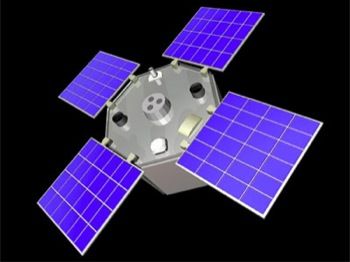
Home - Search - Browse - Alphabetic Index: 0- 1- 2- 3- 4- 5- 6- 7- 8- 9
A- B- C- D- E- F- G- H- I- J- K- L- M- N- O- P- Q- R- S- T- U- V- W- X- Y- Z
ACRIMSAT
 ACRIMSAT Credit: Manufacturer Image |
Status: Operational 1999. First Launch: 1999-12-21. Last Launch: 1999-12-21. Number: 1 . Gross mass: 120 kg (260 lb).
Principal Investigator for the ACRIMSAT's Earth Observing System/Active Cavity Radiometer Irradiance Monitor (EOS ACRIM) III Experiment was Richard Wilson, Columbia University. The Mission Team consisted of JPL for Mission Management and Payload Development; and Columbia University for Science and Data Processing. The purpose of the EOS ACRIM Experiment was to monitor the Total Solar Irradiance (TSI) with maximum precision and provide an important link in the long term TSI database. The ACRIM III experiment would provide all solar maximum TSI results in solar cycle 23. The result would be a science data set of daily average Total Solar Irradiance at 1 AU for the cycle. Objectives were to extend the TSI database accumulated by Nimbus7/ERB, SMM/ACRIM I, UARSUARS/ACRIM II, and SOHO/VIRGO; and to contribute data to the U.S. Global Change Research Program to understand solar influences on climate.
The single payload of the satellite was the Active Cavity Radiometer Irradiance Monitor (ACRIM) IV. This was Sun-pointing (+/-0.25 deg), had a weight of 13 kg, and detected full spectrum wavelengths of 200 nm to 2000 nm. Power draw was10 watts. Instrument Heritage was SMM/ACRIM I (1980-1989); UARS/ACRIM II (1991-); and the Active Cavity Radiometer (ACR) instrument (4 Shuttle Flights). The planned minimum science mission was a five year lifetime in a 680 km orbit, sun-synchronous orbit.
Major Milestones included Project Start: September 1997; Instrument Delivery: April 1999; Launch: December 1999.
Spacecraft Contractor was Orbital Sciences Corporation; Launch Vehicle was an OSC Taurus.
More at: ACRIMSAT.
Family: Earth, Solar, Sun synchronous orbit. Country: USA. Launch Vehicles: Taurus, Taurus 2110. Launch Sites: Vandenberg, Vandenberg 576E. Agency: JPL, NASA, OSC. Bibliography: 2, 3554, 552, 554.
1999 December 21 - . 07:13 GMT - . Launch Site: Vandenberg. Launch Complex: Vandenberg 576E. LV Family: Taurus. Launch Vehicle: Taurus 2110.
- ACRIMSAT - .
Mass: 115 kg (253 lb). Nation: USA.
Agency: JPL,
NASA.
Manufacturer: Germantown.
Class: Earth.
Type: Seismology satellite. Spacecraft Bus: GemStar.
Spacecraft: ACRIMSAT .
USAF Sat Cat: 26033 . COSPAR: 1999-070B. Apogee: 711 km (441 mi). Perigee: 671 km (416 mi). Inclination: 97.80 deg. Period: 98.60 min.
Measured the integrated solar energy output from 0.2 to 2 microns. Carried instrument deleted from Terra spacecraft, studying the total solar output. Failed on 2013 December 14 due to battery problems, months after a review recommended its continued operation. The ACRIM series of experiments, critical data for climate change studies, flew on Solar Max (1980), Spacelab-1 (1983), UARS (1991), and ACRIMSAT. The similar TIM instrument on the SORCE satellite (2003) continued operating, but it was unclear if it would continue in operation until a replacement instrument would be launched on the JPSS satellite in 2017 at the earliest.
Back to top of page
Home - Search - Browse - Alphabetic Index: 0- 1- 2- 3- 4- 5- 6- 7- 8- 9
A- B- C- D- E- F- G- H- I- J- K- L- M- N- O- P- Q- R- S- T- U- V- W- X- Y- Z
© 1997-2019 Mark Wade - Contact
© / Conditions for Use